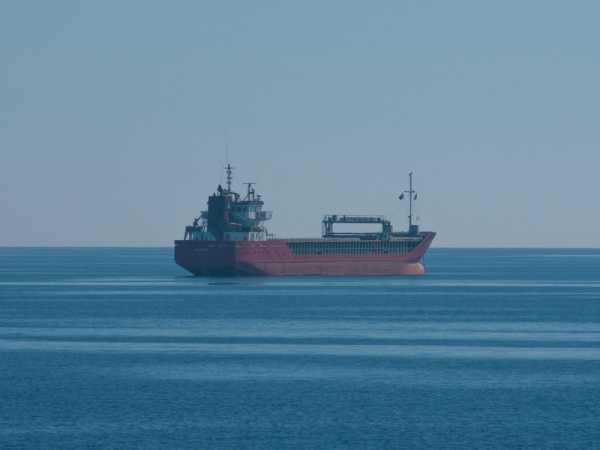
An oil tanker. Over 400 'ghost' or 'shadow' tankers currently help the Kremlin reroute its oil to China and India, who do not participate in the G7 price cap regime (Photo: Pexels – Bartosz Olżewski)
The European Council is currently debating the proposal for a new maritime security strategy. The proposed strategy reflects the EU’s changing threat environment such as Russia’s invasion of Ukraine and the Nordstrom pipeline attacks.
The strategy’s primary aim is to increase member states’ capacities to protect European waters and critical maritime infrastructures and to help ensure global maritime rules and laws against geopolitical adversaries and other threats.
Yet one issue that is conspicuously absent from the document are EU and G7 sanctions designed to control Russian oil shipping.
Enforcing sanctions is conventionally seen as a financial crime and economic management problem that requires market, banking, and business expertise. David O’Sullivan, the EU’s new sanction envoy, for example, is based at the EU’s Directorate‑General for Financial Stability, Financial Services and Capital Markets Union.
Yet shipping sanctions are also a maritime safety and security problem that concerns issues such as maritime crime and grey zone threats. Maritime sanctions need to be part of broader EU efforts to protect critical infrastructures in European waters.
Oil shipping sanctions
The Kremlin relies on European oil markets and shipping services. The European Union has thus banned seaborne oil imports from Russia and imposed a price cap on Russian’s maritime oil sales.
Since 5 December, 2022, EU and G7 companies are no longer allowed to provide shipping and insurance services to vessels that carry Russian oil traded above $60 [€54]. These measures are designed to reduce Russia’s oil income yet ensure its seaborne oil flows and help stabilise global oil markets.
Russia’s shadow tanker fleet
Sanctions produce shadow infrastructures to circumvent and evade regulations. Over 400 “ghost” or “shadow” tankers currently help the Kremlin reroute its oil to China and India, who do not participate in the G7 price cap regime.
Transporting Russian oil outside the West’s price cap is not technically illegal if the vessels don’t use Western shipping, finance, and insurance services.
However, many tankers in Russia’s shadow fleet engage in illicit maritime activities that threaten safety and security at sea.
Russia’s shadow tankers usually sail under so-called flags of convenience (as does most of the world’s shipping fleet) including Cameroon, Palau, and Panama. These flags are privately managed registries that sometimes do not have the capacities or the political will to enforce maritime rules on their vessels. This allows sanction-subverting tankers to obtain fraudulent identification numbers and to register their vessels through anonymous offshore shell companies.
It has been estimated that over 100 vessels currently sail under false flags. Tankers also often switch off or manipulate vessel-tracking systems to conceal their activities from insurers and maritime authorities.
Marine safety risks
Russia’s shadow fleet not only helps the Kremlin subvert European sanctions. It is also a serious threat to Europe’s marine environment. Many Russian tankers are elderly and substandard vessels with questionable insurance and safety standards.
One analysis found that up to 40 tankers carrying Russian crude did not have standard insurance coverage and “routine safety-management certificates.”
Cameroon, a popular flag for Russian sanction subversion activities, has been blacklisted by international port authorities because of its poor safety record.
Dozens of these substandard Russian tankers now regularly pass through the Danish Strait and undertake legal but high risk ship-to-ship oil transfers off Spain’s Ceuta and other areas.
Sign up for EUobserver’s daily newsletter
All the stories we publish, sent at 7.30 AM.
By signing up, you agree to our Terms of Use and Privacy Policy.
The risk of dangerous oil spills and other marine accidents in European waters has increased considerably. The International Maritime Organization, for example, is concerned that Russia’s shadow fleet “posed a real and high risk (…) as they disguised the cargoes’ destinations or origins, or avoided oversight or regulation by flag or coastal states.”
Addressing grey zone threats
Maritime sanction subversion is a grey zone threat. Like attacks on subsea pipelines and data cables, shadow tankers threaten Europe’s critical maritime infrastructures such as ports and shipping lanes. They also endanger fishing activities, marine biodiversity, and Europe’s border blue economy.
The EU’s Russia sanctions will likely last for years, and so will Putin’s shadow tanker threat. The EU therefore needs to urgently address sanctions as part of its maritime security agenda.
First, the EU should enhance its monitoring and surveillance of shadow tankers and other grey zone activities in European waters. And second, it should establish a maritime sanction cell to better coordinate these efforts between member states, including coastguards and maritime port and safety agencies.
Source: euobserver.com



